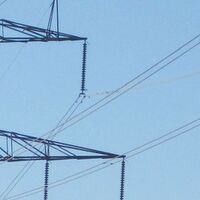Key:wires
| Description |
|---|
| Number of wires per power cable. "single" (1), "double" (2), "triple" (3) or "quad" (4). |
| Group: power |
| Used on these elements |
| Useful combination |
| Status: in use |
| Tools for this tag |
|
To describe the number of wires (better: sub-conductors) per power cable (better: ![]() conductor bundle) of an
conductor bundle) of an ![]() overhead power line section.
overhead power line section.
Background
High voltage transmission lines often use conductor bundles (cables) each consisting of two or more individual sub-conductors (wires) separated by spacers. This has two main purposes:
- Reduction of
 corona discharges. The strong electric field around a conductor can cause ionisation of the surrounding air. This may result in significant power losses and audible noise and it is therefore important to limit such coronal discharges. The electric field can be reduced by increasing the effective diameter of the conductor. A conductor bundle will behave similarly to a single conductor having a diameter roughly corresponding to the diameter of the bundle.
corona discharges. The strong electric field around a conductor can cause ionisation of the surrounding air. This may result in significant power losses and audible noise and it is therefore important to limit such coronal discharges. The electric field can be reduced by increasing the effective diameter of the conductor. A conductor bundle will behave similarly to a single conductor having a diameter roughly corresponding to the diameter of the bundle. - Mitigation of
 skin effect. AC current tend to flow at the surface of conductors. At 50 Hz the current cannot penetrate more than approximately 1 cm into the conductor. It is therefore inefficient to increase the diameter of thick conductors to reduce the electric resistance. A better way to increase the current capacity is to use bundled conductors. A conductor bundle having multiple thin sub-conductors will have a lower resistance than a single solid conductor having an equivalent cross section.
skin effect. AC current tend to flow at the surface of conductors. At 50 Hz the current cannot penetrate more than approximately 1 cm into the conductor. It is therefore inefficient to increase the diameter of thick conductors to reduce the electric resistance. A better way to increase the current capacity is to use bundled conductors. A conductor bundle having multiple thin sub-conductors will have a lower resistance than a single solid conductor having an equivalent cross section.
Conductor bundles are normally used at voltages above 200 kilovolt to limit corona losses but may also be used at lower voltages to increase the current capacity of the line.
A physical property
Please note this is a physical property, qualifying a particular section of a given power line. Power lines may be composed of different sections with a different amount of wires per bundle (sections hasn't been built at the same time, for the same purpose or whatever). It's not recommended to use this key on ![]() route=power objects since a given route can go through several sections with different bundle configurations.
route=power objects since a given route can go through several sections with different bundle configurations.
Example on this 5459752![]() 5459752 route using 479158213
5459752 route using 479158213![]() 479158213 (triple wires section) and 100497456
479158213 (triple wires section) and 100497456![]() 100497456 (two wires section).
100497456 (two wires section).
A note on terminology
The names of the keys wires=* and cables=* may have been chosen a little bit unfortunate. The more common term for "wire" is sub-conductor (IEV ref 466-10-21) of a conductor bundle (IEV ref 466-10-20).
A single conductor (IEV ref 466-10-19) corresponds to wires=single. Similarly twin bundle, triple bundle and quad bundle correspond to wires=double, wires=triple and wires=quad, respectively.
See also conductors on Wikipedia.
Values
| Count | Picture | tag |
|---|---|---|
| 1 |  |
wires=single |
| 2 |  |
wires=double |
| 3 |  |
wires=triple |
| 4 |  |
wires=quad |
| 5 |  |
wires=fivefold |
| 6 |  |
wires=sixfold |
| 8 |  |
wires=eightfold |
Possible values are:
- One wire (no bundle): wires=single
- Two wires: wires=double
- Three wires: wires=triple
- Four wires: wires=quad
Other values are created by appending the phrase 'fold' after the numeral:
Other keys
The number of cables of a line is tagged by cables=* (here ground/earth wires do not count). To distinguish wires and cables use this simple rules:
- Wires are not insulated from one another, but insulated to the tower.
- Cables are insulated from one another and to the tower.
- Ground/earth wires are not insulated to the tower.
